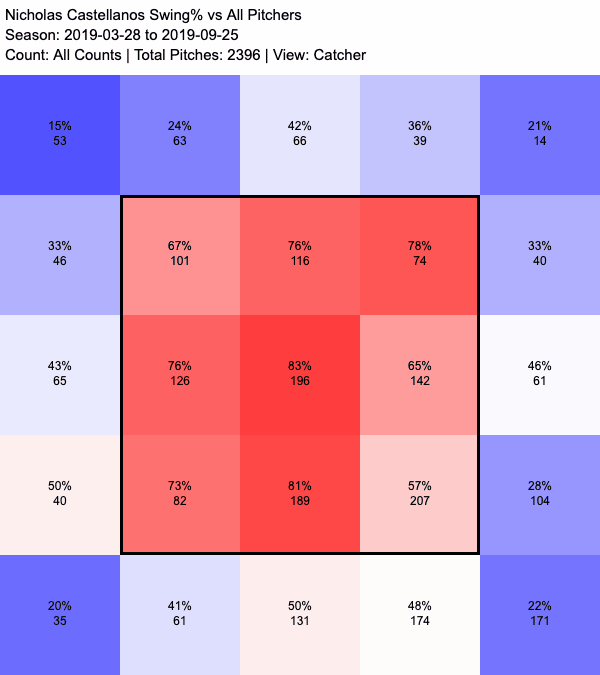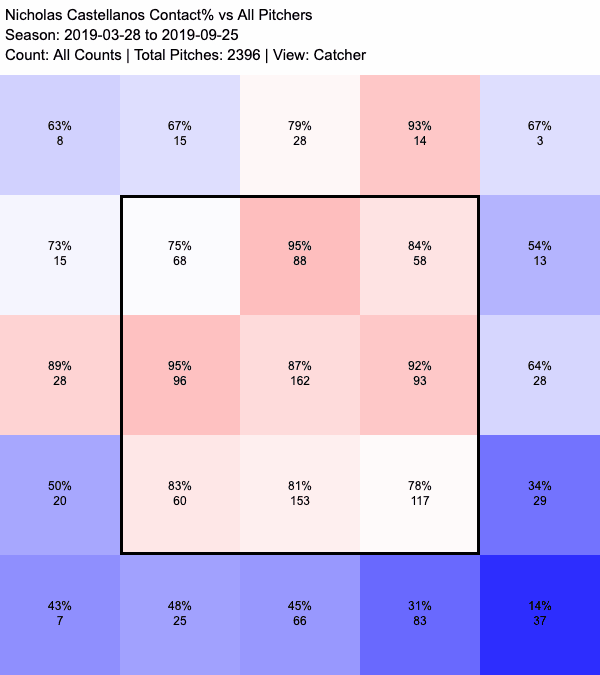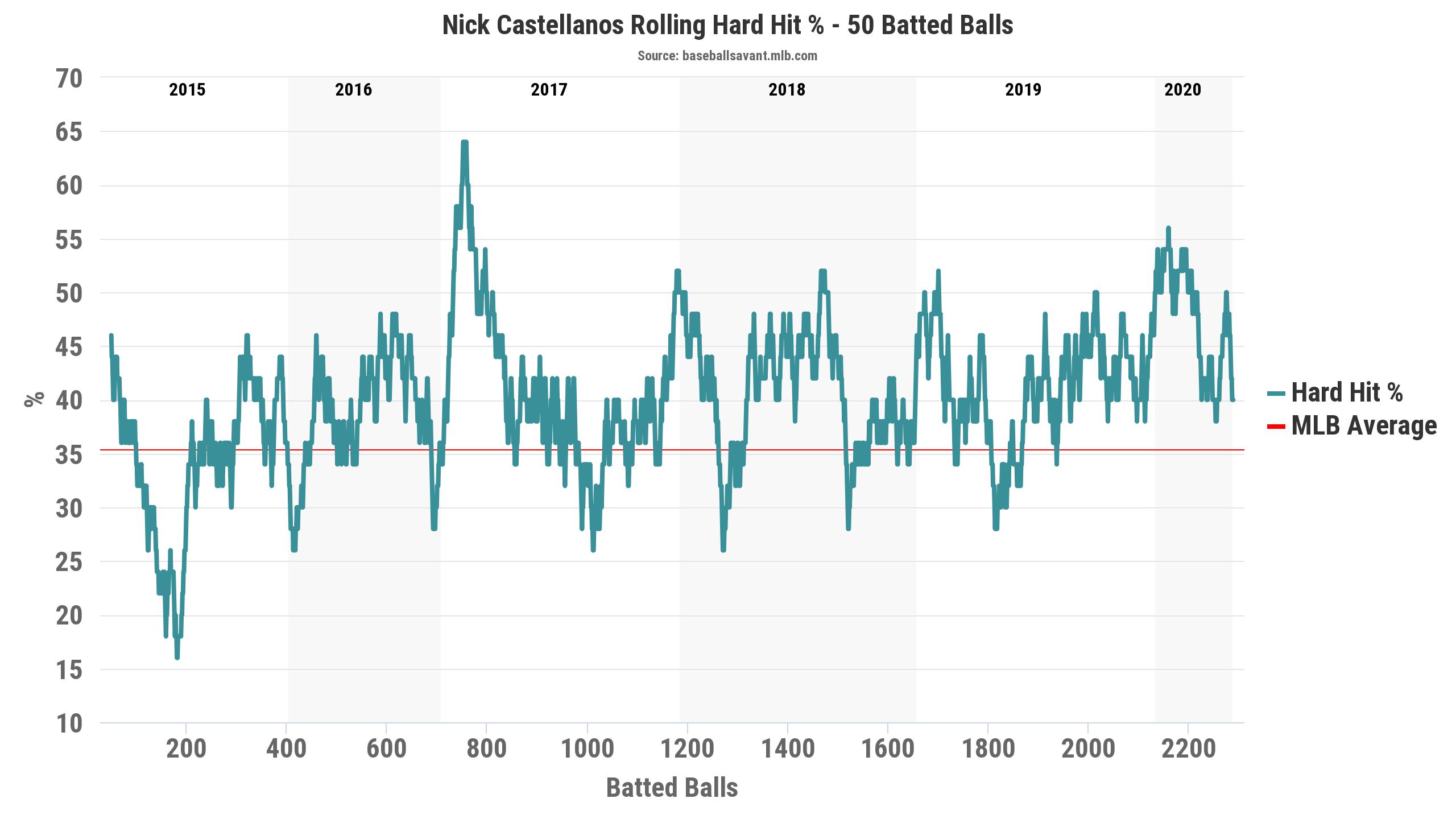If you stopped watching baseball sometime in August 2020, you could be forgiven for wondering if Nick Castellanos had firmly established himself as one of the best hitters in baseball. Over the course of 84 games and 361 plate appearances, starting on August 1, 2019 – his first game with the Cubs after being traded from Detroit – through August 29, 2020, Castellanos post a 153 wRC+. Over that stretch of time, Castellanos was tied for 10th in baseball in wRC+.
And then the bottom fell out. From August 30 through the end of the season, Castellanos posted a 40 wRC+. Just like that, he went from 53% better than league average over roughly half a season to 60% below league average over about one-sixth of a full season.
In a 60 game season, that was enough to undermine his entire season line. By the time all was said and done, Castellanos had posted:
- A career-worst .225 batting average
- A career-worst (other than 18 PA in 2013) .298 OBP
- His worst slugging percentage (.486) since 2015
- His worst wOBA (.329) and wRC+ (102) since 2015
- A career-worst 28.5% strikeout rate
If you stopped watching baseball sometime in August 2019 and checked out Castellanos’s 2020 line, you could be forgiven for wondering if the Reds even want him around anymore.
But when you dig deeper, a different picture emerges and it isn’t so gloomy.
Contact Issues Leading to Strikeouts
I know we just said the picture would not be so gloomy, but we are going to start with the gloom.
Coming into 2020, Castellanos had a career 23.0% strikeout rate, and from 2017-2019 it was even better, at 21.7%. In 2020, it was 28.5%. Striking out that much more goes a long way to explaining how some of those rate stats dropped so low.
However, Castellanos also posted a career-high walk rate of 7.9%, and his .28 BB/K ratio was exactly the same as his career number coming into 2020. He chased fewer pitches than the previous couple of years and pitchers, perhaps fearing the power display he put on over that great 84-game stretch, challenged him less than ever. There was just one problematic area.
| Year | O-Swing% | Z-Swing% | Swing% | O-Contact% | Z-Contact% | Contact% | Zone% | F-Strike% |
| 2017 | 34.6% | 73.2% | 51.2% | 59.2% | 83.9% | 74.3% | 42.9% | 63.9% |
| 2018 | 38.6% | 78.8% | 55.1% | 52.5% | 84.4% | 71.2% | 41.0% | 65.3% |
| 2019 | 40.9% | 76.3% | 54.7% | 58.5% | 87.9% | 74.5% | 39.0% | 61.9% |
| 2020 | 38.2% | 74.9% | 51.8% | 49.1% | 84.0% | 67.8% | 37.1% | 61.6% |
| Career | 36.6% | 74.5% | 52.6% | 54.5% | 84.9% | 72.% | 42.2% | 63.5% |
I highlighted the offending cell in red, just in case the glaring difference didn’t jump out. Castellanos took a huge dive in his ability to make contact on pitches outside the zone. Even as he chased less than he had the last couple of years, he swung through those pitches more often. The result was an increase in swinging strikes on pitches outside the zone.
As pitchers have challenged Castellanos less, he has taken fewer called strikes, and the fewer pitches in the zone coupled with a Z-swing rate around his career norms meant he didn’t see a jump in swinging strikes in the zone. Outside the zone, it was ugly. The table below shows certain pitch results as a percent of all pitches to Castellanos.
| Year | Called strikes | Swinging strikes in the zone | Strikes chasing | Total strikes |
| 2013 | 6.5% | 3.4% | 6.5% | 16.4% |
| 2014 | 11.4% | 3.4% | 8.9% | 23.8% |
| 2015 | 13.1% | 3.5% | 9.0% | 25.7% |
| 2016 | 11.8% | 3.7% | 9.5% | 25.0% |
| 2017 | 11.5% | 3.5% | 8.1% | 23.1% |
| 2018 | 8.7% | 3.5% | 10.8% | 23.0% |
| 2019 | 9.2% | 2.6% | 10.4% | 22.2% |
| 2020 | 9.3% | 3.1% | 12.2% | 24.6% |
| Career | 10.8% | 3.4% | 9.6% | 23.7% |
More pitches to Castellanos ended up strikes than he had seen since 2016, and it was almost entirely due to an increase in swinging strikes on pitches he chased. This was not entirely his fault—as noted above, he saw more pitches outside the zone. But had he met his career O-contact rate (54.5%), he would have ended up with 10.9% chased strikes—still the most in his career, but very much in-line with 2018 and 2019. His total strikes would have been at 23.3%, again, very much in-line with his recent seasons.
So if worse contact on pitches, primarily those outside the zone, was the main driver for his increased strikeout rate, why did his contact rate plummet? One factor might be the pitches Castellanos chose to swing (or not swing) at. The GIF below shows his swing rates by zone for 2019 vs. 2020.
Castellanos was a bit more likely to chase up and out of the zone, about as likely to chase down and out of the zone (a little less, particularly on balls down and in), and less likely to chase both in and out off the plate. The image below shows contact rate by zone for 2019-20.
Here are his contact rates in the four zones outside the strike zone, where his swing rate increased by more than five percentage points: 61%, 73%, 35%, 75%. And here are his contact percentages in the seven zones where his swing rate decreased by more than five percentage points: 57%, 67%, 61%, 88%, 56%, 67%, 89%. The zones where he moved by five points or less in either direction were his worst overall – 40%, 9%, 35%, 41%, 30%.
So part of the issue is that his O-swing was more likely to go up in zones where he was already making less contact and down in zones where he was making more contact, but look at the GIF below.
2020 has less pink and more dark blue. Of the 16 locations outside the strike zone, Castellanos saw his contact rate drop in 11. Of the four zones in which his contact rate increased, two were just one swing each and one was an increase from 75% to 78% which, given the sample sizes, isn’t meaningful. To be fair, many of the zones where he lost contact rate were also arguably a result of a small sample size, but there is a pattern here—Castellanos had a harder time connecting with pitches in 2020 than he did in 2019.
Maybe Less Contact is Better?
That said, sometimes less is more, and while Castellanos made less contact outside the zone, he made better contact basically everywhere.
His average exit velocity (91 mph) crossed 90 for the first time in his career. He posted a career-high barrel rate (16%) and a career-high hard-hit rate (46.7%). And while it might be just noise, there does seem to be some evidence he actually hit the ball harder more consistently.
Other than a brief spike early in 2017, Castellanos has never posted a rolling hard-hit rate higher than the 58% he hit early in 2020. His secondary 2020 peak (54% just a few days later) is also higher than anything since that 2017 peak. That late peak in 2020 hit 50%, a number he only hit three times in 2018 and 2019 combined. While 2017-2019 included multiple valleys well below MLB average, 2020 Castellanos never dropped that far. Maybe with another 102 games, he would have hit that valley, but there is a pretty clear upward trend starting mid-2019 and continuing through 2020.
With all that harder contact, why did his xBA and xwOBA drop per that graphic above? The strikeouts. As a hitter, you need to both make good contact and make contact often, and Castellanos did the former, but not the latter.
There also appears to be some noise in the results from that harder contact. His home run power certainly increased. Coming into 2020, he had a career 12.2% homerun per flyball rate on a 38.6% flyball rate. In 2020, he maintained the flyball rate (39.3%) but with a 23.7% HR/FB rate, by far the highest of his career. However, his BABIP plummeted.
Castellanos has traditionally been a high BABIP hitter, thanks to a lot of line drives and solid contact, and he came into 2020 with a career .333 BABIP. The .257 he put up in 2020 looks low for anyone, but it is particularly low for a high-BABIP guy like Castellanos. He easily could have been .070-.080 higher without an outlier season. Given that he had no large increase in flyballs, hit more line drives (26.0%) than he has in the past (25.4% for his career coming into the year), and was hitting the ball harder than ever before, this drop in BABIP is pretty surprising. Sure enough, on Baseball Savant’s xStats leaderboard, Castellanos has the 7th largest drop from his xBA to his actual batting average.
If we correct that BABIP from .257 to closer to his career line, he adds 10 hits on balls in play, giving him a .331 BABIP and adding about seven singles and three doubles. That would leave him with this shift in his slash line:
| AVG | OBP | SLG | BABIP | |
| Actual 2020 | 0.225 | 0.298 | 0.486 | 0.257 |
| “Corrected” 2020 | 0.271 | 0.339 | 0.546 | 0.331 |
| Pre-2020 Career | 0.277 | 0.326 | 0.471 | 0.333 |
That would be a career-high SLG and the second-best OBP of his career. In 2020, Kole Calhoun posted a .338 OBP and .526 SLG for a 125 wRC+. That’s probably a solid comp for the kind of offensive season Castellanos might have had with better batted-ball luck, and it is a big jump from his actual 102 wRC+. In fact, after posting a 129 in 2018 and a 121 in 2019, had he posted a 125 in 2020, we would be talking about his establishing a new baseline moving forward.
But that is assuming he keeps his contact quality gains and his contact quantity losses. It’s worth exploring what might have driven those changes.
Swing Change
It takes about two seconds to see a difference in 2020 Castellanos and 2019 Castellanos. In fact, here are two clips, two seconds each, to prove it. The first is from 2019, the second from 2020.
You can see immediately he was much quieter in 2019. He’s practically still, whereas, in 2020, the bat is waggling around all over the place as the pitcher is getting ready to deliver. Now, I’ll admit I picked out extreme examples, but let’s look at some more clips. Here’s a 2019 swing-and-miss compared to one from 2020.
The 2019 plate appearance is not quite as quiet as the clip above but still much quieter than the 2020 whiff. You’ll also notice that in the 2020 clip, Castellanos has more of a load as the pitcher is delivering; even with the 2019 waggling bat, he is still and in position to take his leg kick when it is time to swing.
Given what we learned above—lower contact rate but better contact quality—it’s hard to know what to make of the increased pre-swing movement. Is it causing him to be out of position, increasing swing and miss? Is it serving as a timing mechanism, getting more momentum into his swing and increasing his power? Maybe both?
Well, way back at the top, we talked about how Castellanos had a great run starting in August 2019, not August 2020. You’ll notice that the nice, quiet, almost statuesque stance from 2019 is in Cubbie blue – it’s from after the hot streak started. And his numbers from the end of 2019 are an interesting comparison to his 2020.
Those last two months of 2019 already showed gains in contact quality. His average exit velocity was 90.2 (remember, 2020 was his first season over 90). He had a 45.8% hard-hit rate (remember, in 2020 he set a career-high at 46.7%). His barrel-rate was 14.5% (remember, he set a career-high of 16% in 2020). His HR/FB rate was 23.2% (remember, he posted a career-high 23.7% in 2020). All four of those numbers would have been career highs if they were full-season stats, and he improved on all four in 2020.
But he made those gains in 2019 without the same contact issues. His strikeout rate was 20.9% and his O-contact (51.5%) and Z-contact (86%) were both better than his 2020 numbers. The O-contact was down from his career level, but not as much.
I’m not a hitting coach, but it looks to my eye like Castellanos could quiet his swing down, get back some of the contact quantity he lost, and still keep the contact quality gains.
It’s not immediately clear to me why he started hitting the ball so much harder when he got to Chicago. Maybe he got a tip from a new coach or teammate, maybe something else just clicked. But there is a clear upward trend in his contact quality starting in August 2019, and that trend hasn’t stopped yet.
It does appear that his increased swing-and-miss issues coincide with a noisier bat pre-swing. Correlation is not causation, but it is interesting, nonetheless.
What to Look For
First of all, I think that 125-ish wRC+ suggested earlier, after adjusting for BABIP, is a pretty good reflection of Castellanos’s true 2020 performance. He is much better than his final line appeared, and in 2021, I suspect we’ll get “more of the same,” where the same means something 20%-30% better than league-average.
However, I wonder if Castellanos didn’t unlock something late in 2019 that he is still adjusting to. Perhaps with more time, he’ll bring the contact rates back up and the strikeout rates down, even a little bit. We’re getting close to wishcasting here, but what would Castellanos’s 2020 have looked like with that .331 BABIP and something closer to his career strikeout rate?
If you take away 13 strikeouts and turn those into balls in play (let’s assume none become walks or HR, to simplify things), he ends up with something like this:
| AVG | OBP | SLG | BABIP | K% | |
| Actual 2020 | 0.225 | 0.298 | 0.486 | 0.257 | 28.5% |
| Corrected 2020 | 0.289 | 0.355 | 0.578 | 0.329 | 23.1% |
| Pre-2020 Career | 0.277 | 0.326 | 0.471 | 0.333 | 23.0% |
I wouldn’t bet on this, but this isn’t “what if Castellanos suddenly learns a new skill” or “what if Castellanos starts elevating the ball more”—the kind of projection we do all the time to look at what a guy is capable of. This is, “what if the contact quality Castellanos has demonstrated since August 2019 is legit and the strikeout issues that didn’t show up until 2020 are just small sample size noise?” After all, through August 6, 2020, Castellanos had a 23.5% strikeout rate. His bad stretch was just 47 games and 191 plate appearances of a 29.8% strikeout rate from August 7 through the end of the year.
I don’t want to pay full price for that upside, but his ADP (86.0 at NFBC) is only a touch higher than his 2019 (93.6) and 2020 (91.8) ADP, even though he set a new standard for power. If you pay that price and get the 120-130 wRC+ I think is fair to expect, you’ll be very happy. If he brings the strikeouts back in line while keeping the power gains, you’ll be getting a steal.
Photo by Frank Jansky/Icon Sportswire| Adapted by Doug Carlin (@Bdougals on Twitter)






Great job Chad – my inner Reds fan is pleased!